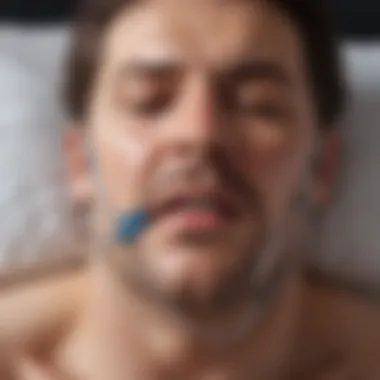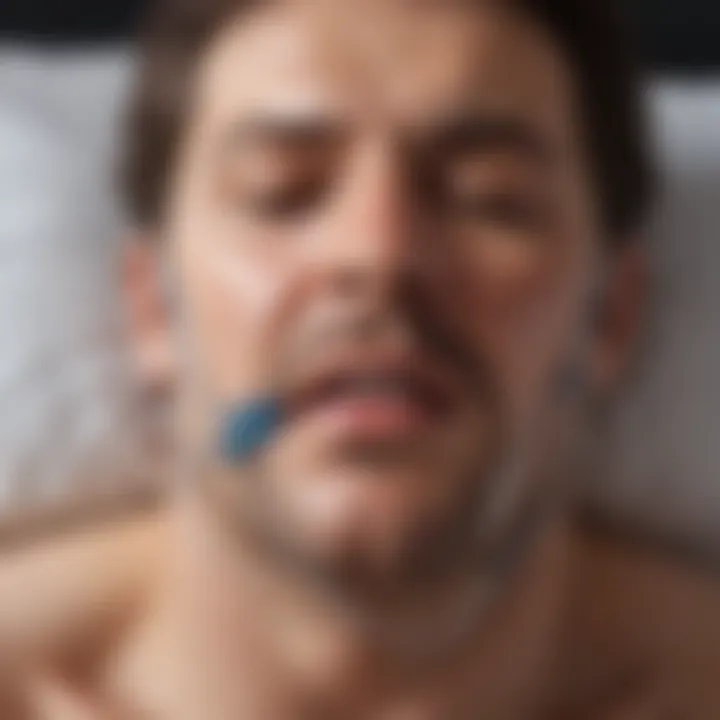Sleep Apnea and Nightmares: An In-Depth Analysis


Intro
Sleep apnea is a sleep disorder characterized by repeated interruptions in breathing during sleep. These disturbances can lead to poor sleep quality and have multiple health implications. Nightmares, on the other hand, represent distressing dreams that can evoke strong feelings of fear or anxiety, disrupting overall sleep experience further. Both conditions affect millions globally, and a correlation between them emerges in various studies.
Understanding the nexus between sleep apnea and nightmares is essential for clinicians and researchers. The interplay between the physiological disruptions caused by sleep apnea and the psychological effects of nightmares presents a complex scenario worthy of investigation.
This article aims to methodically explore this relationship, shedding light on the implications for mental and physical health while considering potential treatment options and coping strategies. The insights gathered here can contribute meaningfully to a better understanding of how these two phenomena influence each other.
Preamble to Sleep Apnea
Sleep apnea is a sleep disorder characterized by repeated interruptions in breathing during sleep. It is not just a nuisance; it has serious implications for overall health and quality of life. Understanding sleep apnea is crucial for those who may experience its effects or know someone who does. This condition can lead to daytime fatigue, cardiovascular issues, and even cognitive decline. Therefore, recognizing its importance in the broader context of sleep health is necessary.
Definition and Classification
Sleep apnea can be classified into three primary types: obstructive sleep apnea, central sleep apnea, and complex sleep apnea.
- Obstructive Sleep Apnea (OSA) is the most common form. It occurs when the throat muscles relax excessively during sleep, blocking the airway. As a result, the individual experiences numerous breathing stops throughout the night, often creating snoring sounds or gasping for air.
- Central Sleep Apnea (CSA) is less frequent. In this case, the brain fails to send proper signals to the muscles that control breathing. This type is often associated with underlying medical conditions, such as heart disease.
- Complex Sleep Apnea Syndrome is a combination of both OSA and CSA. It involves elements of both forms and may require comprehensive evaluation for effective management.
Understanding these definitions and classifications helps in identifying symptoms and seeking appropriate treatment.
Prevalence and Demographics
The prevalence of sleep apnea varies widely, affected by factors including age, gender, and lifestyle choices. Studies indicate that approximately 2–4% of adults suffer from obstructive sleep apnea, with a higher occurrence in males than females. However, as women age, particularly post-menopause, their risk increases significantly, making this a concern for both genders.
In addition, obesity is a well-known risk factor associated with sleep apnea. Individuals who are overweight may have excess tissue in the throat area, which can lead to blockages in the airway during sleep. Furthermore, it is essential to recognize cultural and geographic differences in the prevalence of sleep apnea and its recognition.
"Understanding the demographics and prevalence of sleep apnea can aid clinicians in better identifying at-risk populations."
Each of these factors guides the development of targeted interventions, highlighting the need for increased awareness in the clinical settings. This opening section lays the groundwork for understanding the subsequent discussions about the connections between sleep apnea and nightmares, emphasizing the significance of addressing and treating this disorder.
Understanding Nightmares
Nightmares are significant disturbances that can affect the quality of sleep and, consequently, one’s overall well-being. Understanding the nuances of nightmares is crucial in the context of sleep apnea, as the two conditions can interrelate in various ways. Sleep apnea, characterized by interruptions in breathing during sleep, leads to fragmented and poor-quality sleep. This disordered sleep can provoke and exacerbate nightmares, making the study of their characteristics and psychological effects essential for both prevention and treatment.
Definition and Characteristics
Nightmares are vivid and distressing dreams that often evoke strong negative emotions, such as fear, anxiety, or sadness. They commonly occur during the rapid eye movement (REM) stage of sleep, a period associated with increased brain activity and dreaming.
Characteristics of nightmares include:
- Content: Nightmares often contain threatening scenarios, such as being chased, falling, or losing loved ones.
- Intensity: Many individuals report feelings of panic or terror during nightmares, leading to abrupt awakenings.
- Recall: Unlike regular dreams, nightmares are more likely to be remembered upon waking, often leading to fear of sleep and resulting sleep avoidance.
- Frequency: The occurrence of nightmares can vary widely among individuals. Some may experience them occasionally, while others may suffer from chronic nightmares.
Recognizing these elements is essential for understanding the broader implications of nightmares, especially for those suffering from sleep apnea.
Psychological Effects of Nightmares
The psychological ramifications of nightmares are profound and multifaceted. They can contribute to an array of mental health challenges, including increased anxiety, stress, and depression. Surviving frequent nightmares can create a cycle of fear surrounding sleep, ultimately leading to sleep deprivation and exacerbating existing health conditions.
Some psychological effects include:
- Increased Anxiety: Individuals may become apprehensive about the prospect of sleeping, fearing the return of nightmares.
- Mood Disorders: The unpredictability and distress associated with nightmares can contribute to larger mood disorders.
- Sleep Avoidance: Nightmares may lead individuals to avoid sleep altogether, further perpetuating insomnia and other sleep disorders.
- Impaired Functioning: Daytime functioning may decline due to poor sleep, affecting cognitive abilities and emotional regulation.
The interplay between nightmares and psychological well-being underlines the necessity of addressing these disturbances. In cases of sleep apnea, where nightmares may be prevalent, understanding these psychological effects becomes even more critical for devising effective treatments and coping strategies.
According to research, nightmares not only influence mental health but also can be symptomatic of underlying sleep disorders like sleep apnea.
Physiological Mechanisms of Sleep Apnea
Understanding the physiological mechanisms of sleep apnea is crucial to fully grasp the implications it holds for individuals affected by the disorder. Sleep apnea disrupts regular sleep patterns and can exacerbate other conditions such as nightmares. These mechanisms also inform treatment options and coping strategies. With a well-rounded understanding, practitioners can better address the complexities associated with both sleep apnea and nightmares.


Obstructive Sleep Apnea Explained
Obstructive sleep apnea (OSA) is the most common form of sleep apnea. It occurs when the muscles in the throat relax excessively during sleep, leading to a blockage of the upper airway. This condition presents serious challenges, as intermittent breathing interruptions can disturb the normal sleep cycle.
The primary physiological characteristics of OSA include repeated episodes of apnea, where breathing stops for a duration of ten seconds or longer. This often results in decreased oxygen levels in the blood, triggering the brain to wake the individual from sleep. The consequences of this disruption can be severe. OSA can lead to excessive daytime sleepiness, decreased cognitive functioning, and various cardiovascular complications.
Additionally, OSA is linked to increased stress hormones, such as cortisol. High levels of these hormones can lead to heightened anxiety and disturbances in emotional regulation, potentially increasing the likelihood of experiencing nightmares.
Central Sleep Apnea Overview
Central sleep apnea (CSA) differs fundamentally from obstructive sleep apnea. It arises from a failure in the brain to send proper signals to the muscles that control breathing. Unlike OSA, CSA does not involve any airway obstruction. Instead, it results from various factors, such as heart failure or stroke, which affect the brain’s respiratory centers.
Individuals with CSA may experience periods of no breathing during sleep, which can lead to fragmented sleep patterns. This disruption can result in symptoms similar to those of OSA, such as increased tiredness during the day and difficulties concentrating. Moreover, the irregularity of CSA episodes can cause unpredictable shifts in sleep architecture, potentially resulting in heightened occurrences of nightmares.
CSA has been observed in patients with underlying health conditions, amplifying the need for comprehensive evaluation and tailored treatment strategies.
In summary, understanding these physiological mechanisms provides insight into how sleep apnea can intertwine with the experience of nightmares. Addressing both obstructive and central sleep apnea requires a multifaceted approach, encompassing medical, psychological, and lifestyle considerations.
Nightmares: Triggers and Causes
Understanding the reasons behind nightmares is essential, especially when they intersect with sleep apnea. Nightmares can significantly affect sleep quality and overall well-being. By identifying the triggers and causes of nightmares in individuals with sleep apnea, healthcare professionals can develop effective treatment and management strategies. This section focuses on the psychological aspects that contribute to nightmares and how sleep disorders, such as sleep apnea, may amplify these experiences.
Common Psychological Triggers
Nightmares often have psychological roots. Common triggers include:
- Stress: Daily stressors, whether personal or professional, can seep into sleep, causing vivid nightmares.
- Trauma: Past traumatic events can resurface in dreams, manifesting as nightmares.
- Anxiety Disorders: Conditions such as generalized anxiety disorder can enhance the frequency of nightmares.
- Depression: Individuals with depressive symptoms may find that their dreams turn darker, reflecting their emotional state.
Each of these triggers can vary from person to person. It's important to recognize that for individuals suffering from sleep apnea, these psychological triggers may combine with physiological factors, resulting in a greater likelihood of experiencing nightmares.
"Nightmares can serve as a reminder of unresolved issues or conflicts, making their identification crucial for treatment."
Impact of Sleep Disorders
Sleep disorders, notably sleep apnea, play a significant role in the development and quality of nightmares. The fragmented sleep experienced by individuals with sleep apnea can precipitate the following:
- Increased Stress Hormones: Disrupted sleep can lead to elevated cortisol levels, which may influence nightmares.
- Sleep Fragmentation: Frequent awakenings interrupt sleep cycles, preventing deep restorative sleep and increasing the chances of vivid dreams and nightmares during REM sleep.
- Hyperarousal: Individuals with sleep apnea often exhibit signs of hyperarousal, which may contribute to anxiety and, consequently, more nightmares.
The relationship between sleep disorders and nightmares emphasizes the necessity for comprehensive evaluations. Addressing both the psychological and physiological components of sleep apnea can provide a pathway to alleviate the burden of nightmares, leading to better sleep health.
Connection Between Sleep Apnea and Nightmares
The relationship between sleep apnea and nightmares is significant. Both conditions share common ground in their impact on overall sleep quality and mental health. When sleep is disrupted, it can lead to a greater incidence of nightmares among those affected. This section seeks to uncover the specifics of this connection, providing insight into the frequency of nightmares in sleep apnea patients and how sleep fragmentation influences dream disturbance.
Frequency of Nightmares in Sleep Apnea Patients
Research indicates that individuals with sleep apnea frequently report experiencing nightmares. It is estimated that nearly 50% of sleep apnea sufferers experience these unpleasant dreams. This trend raises multiple questions about the connection between sleep disruptions caused by apnea and the subsequent nightmares. Nightmares can manifest from various sleep disturbances such as the inability to transition smoothly through sleep stages.
A study observed that patients with obstructive sleep apnea, in particular, frequently woke during the night gasping for air. This startling experience interrupts the REM sleep phase, which is crucial for reaping the mental benefits of sleep. As a result, patients often report vivid and disturbing dreams. Some patients may not only have nightmares more often but also remember them vividly due to fragmented sleep.
Sleep apnea leads to altered sleep architecture. REM sleep is when most dreams occur, and disturbances during this phase may cause nightmares to be more common among these individuals. Understanding the frequency and nature of these nightmares can help in tailoring effective therapeutic approaches for those suffering from both conditions.
Sleep Fragmentation and Dream Disturbance
Sleep fragmentation is a cornerstone in understanding the connection between sleep apnea and nightmares. In sleep apnea, frequent arousals occur due to the airway obstruction, leading to abrupt awakenings. This interrupts the natural circadian rhythm and prevents entering or sustaining restorative sleep cycles.
The fragmentation affects REM sleep negatively, which can result in a reduced ability to process emotions and experiences from the day. As the brain attempts to reconcile daytime stressors, dreams can become distorted and morphed into unsettling narratives during the night.
Furthermore, sleep fragmentation is linked to increased sympathetic nervous system activity, leading to heightened anxiety levels. This can enhance emotional responses during dreaming, often leading to disturbing dreams.
Research has shown a direct link between the severity of sleep fragmentation and the intensity of nightmares. The more a person experiences disruptions, the more likely they are to recall nightmares that may amplify their feelings of fear or anxiety.


"Understanding the interplay between sleep disorders and mental health is crucial for developing effective management strategies."
In summary, the nexus between sleep apnea and nightmares continues to intrigue researchers and clinicians alike. It underscores the need for a multidisciplinary approach when treating patients. By focusing on the frequency of nightmares and the implications of sleep fragmentation, healthcare providers can better address the needs of those suffering from these intertwined conditions.
Diagnosis of Sleep Apnea
Identifying sleep apnea is crucial to understanding its implications on overall health, particularly in relation to nightmares. A proper diagnosis paves the way for effective treatment and management of symptoms. Comprehending how sleep apnea manifests itself through various clinical signs and the tools used for diagnosis can significantly improve patient outcomes. Delaying diagnosis may exacerbate both sleep apnea and associated nightmares, resulting in potential long-term health issues.
Clinical Evaluation and Symptoms
Clinical evaluation begins with a thorough patient interview, focusing on medical history, lifestyle, and symptom reporting. Common symptoms include loud snoring, choking or gasping during sleep, excessive daytime sleepiness, and morning headaches. Individuals may also notice mood changes and cognitive impairments due to disrupted sleep.
"A detailed history remains invaluable in the identification of sleep apnea's impact on sleep and mental health."
Family members' observations can also provide critical insights. Furthermore, a physical examination helps to rule out any anatomical factors contributing to airway obstruction. Understanding these initial clinical signs allows healthcare providers to ascertain the need for further diagnostic procedures.
Polysomnography: The Gold Standard
Polysomnography is recognized as the gold standard in sleep apnea diagnosis. This comprehensive overnight sleep study records various bodily functions during sleep, including brain activity, eye movement, heart rate, and oxygen levels.
The procedure generally unfolds as follows:
- The patient is monitored in a sleep lab or at home with portable devices.
- Electrodes record brain activity through an EEG, while belts measure respiratory effort.
- An oximeter tracks oxygen saturation levels in the blood.
Data collected helps specialists identify the presence and severity of sleep apnea. It also distinguishes between obstructive types and central sleep apnea. This indepth assessment opens avenues for tailored treatment options to address both sleep apnea and night terrors, leading to improved sleep quality and overall well-being.
Impact of Treatment on Nightmares
The treatment of sleep apnea plays a crucial role not only in improving sleep quality but also in mitigating the frequency and intensity of nightmares experienced by affected individuals. Understanding the impact of treatment on nightmares is essential for both healthcare providers and patients. This section will delve into the mechanics of how targeted therapies can alleviate nightmare occurrences and improve overall psychological well-being.
Firstly, effective management of sleep apnea directly correlates with the restoration of normal sleep patterns. Individuals suffering from sleep apnea often endure frequent awakenings due to breathing interruptions. Such disturbances can trigger vivid dreams and nightmares, disrupting the natural sleep cycle. Treating sleep apnea, therefore, leads to more consolidated sleep and can significantly reduce the incidence of nightmares.
Additionally, implementing appropriate treatments helps ease the anxieties and stresses associated with poor sleep quality. These psychological factors often contribute to the amplification of nightmare experiences. Treatment also addresses the physiological aspects of sleep disturbances, creating a multifaceted approach to improving overall sleep health. This aspect underscores the importance of integrating both physical and psychological treatment considerations in managing nightmares.
Continuous Positive Airway Pressure (CPAP) Therapy
Continuous Positive Airway Pressure (CPAP) therapy is one of the most common and effective treatments for obstructive sleep apnea. It involves the use of a machine that delivers a continuous stream of air through a mask while the patient sleeps. This air pressure keeps the upper airway passages open, preventing the interruptions that characterize sleep apnea.
Benefits of CPAP therapy include:
- Reduction in Nightmares: CPAP therapy helps stabilize breathing patterns, which can lead to a marked decrease in the occurrence of nightmares. With a more regular sleeping pattern, individuals find it easier to engage in restful sleep.
- Improved Sleep Quality: Users often report fewer disruptions and better overall sleep quality. With increased REM sleep, the brain may process and integrate memories more effectively, possibly lessening the likelihood of frightening dreams.
- Psychological Benefits: Better sleep translates to enhanced mood and reduced anxiety. This mental state can alleviate the frequency and severity of nightmares.
However, some challenges exist with CPAP therapy. Not all individuals adapt easily to the equipment, which may initially cause discomfort, affecting compliance. Education regarding its importance, along with counseling for adaptation, can facilitate better outcomes.
Cognitive Behavioral Therapy for Insomnia
Cognitive Behavioral Therapy for Insomnia (CBT-I) represents an effective non-pharmacologic treatment that targets both sleep apnea and associated nightmares. CBT-I focuses on addressing the underlying thoughts and behaviors that contribute to sleep disturbances.
Key components of CBT-I include:
- Sleep Hygiene Education: Teaching patients about healthy sleep practices can foster an environment conducive to restful sleep, thereby minimizing nightmares.
- Cognitive Restructuring: This involves challenging negative thoughts that may exacerbate the perception of nightmares. By reshaping one's mindset, patients can diminish the emotional intensity tied to the dreams.
- Imagery Rehearsal Therapy: This technique helps patients change their nightmare narratives through rehearsal of a positive outcome. Thus, it reduces the emotional impact of recurring dreams.
In summary, both CPAP therapy and CBT-I serve as potent tools in the management of sleep apnea and its related nightmare experiences. These treatments not only address physiological needs but also consider the psychological facets that contribute to the complexity of sleep disorders. Their integration into a cohesive treatment plan may significantly enhance the sleep experience for those affected by both conditions.
Managing Nightmares Associated with Sleep Apnea
The interplay between sleep apnea and nightmares is complex. Managing nightmares related to sleep apnea is integral to improving the overall quality of life for those affected. This section will dive into specific methods and considerations that can address these distressing experiences. Nightmares can exacerbate feelings of anxiety and poor sleep quality, creating a cycle that is difficult to break. Hence, finding effective management strategies is crucial for mental health and well-being.
Psychotherapeutic Approaches


Psychotherapeutic approaches can provide effective solutions for individuals experiencing nightmares linked to sleep apnea. Several methods are being explored:
- Cognitive Behavioral Therapy (CBT): This form of therapy focuses on identifying negative thought patterns and replacing them with more constructive thoughts. CBT can help individuals analyze their nightmares and alter their responses, which can lead to reduced frequency and intensity.
- Imagery Rehearsal Therapy (IRT): A recognized method wherein individuals rewrite the narrative of their nightmares. Practicing a more positive ending to their dreams can lead to changes in how these nightmares manifest.
- Exposure Therapy: This therapeutic technique focuses on gradually exposing individuals to the thoughts of nightmares, helping them to process their fears and reduce anxiety responses.
Regardless of the approach, therapy can foster a deeper understanding of the triggers causing nightmares. Collaboration with a trained mental health professional is often necessary for the best outcomes.
Lifestyle Modifications
Lifestyle modifications can supplement therapeutic measures in managing nightmares associated with sleep apnea. Some adjustments include:
- Sleep Hygiene: Maintaining a regular sleep schedule is essential. Practicing good sleep hygiene can help regulate one’s sleep cycle, potentially minimizing nightmares.
- Avoiding Stimulants: Reducing caffeine and nicotine intake, particularly in the evening, may improve sleep quality and lessen the occurrence of nightmares.
- Creating a Relaxing Bedtime Routine: Engaging in calming activities, such as reading, meditative practices, or gentle stretching, can help set a peaceful tone for sleep.
- Physical Activity: Regular exercise is known for its sleep-enhancing benefits. However, it is best to avoid vigorous workouts close to bedtime to prevent overstimulation.
In essence, avoiding negative influences on sleep can have a positive impact on reducing nightmares. Taking proactive steps can empower individuals to gain control over their sleep experience, highlighting the connection between lifestyle and sleep quality.
Managing nightmares effectively can lead to improved mental health and a better quality of life for individuals with sleep apnea.
Future Directions in Research
Research concerning the connection between sleep apnea and nightmares is still evolving. As we delve deeper into this relationship, it becomes crucial to pinpoint advanced insights that will enhance our understanding and treatment strategies. This section will focus on two crucial areas: investigating the long-term effects of treatments and examining the role of neurobiology in sleep disorders.
Investigating Long-term Effects of Treatments
Longitudinal studies are essential in understanding how different treatments for sleep apnea affect nightmares over time. Continuous Positive Airway Pressure (CPAP) therapy is common, yet its long-term effectiveness in reducing nightmares is not fully understood. For instance, some patients report fewer nightmares after starting CPAP. In contrast, others continue to have vivid dreams even with regular use. Understanding these variances can provide valuable insights.
- Potential Areas of Study:
- Patient Compliance: How adherence to treatments impacts outcomes.
- Psychological Factors: The role of individual mental health status in responding to treatments.
- Objective Measurements: Using polysomnography over extended periods can reveal changes in sleep architecture and dream patterns.
Further exploration in this area may lead to personalized treatment plans, increasing efficacy and improving the overall quality of life for those affected by both sleep apnea and nightmares.
The Role of Neurobiology in Sleep Disorders
Neurobiology plays a pivotal role in how sleep disorders manifest. Understanding the neural mechanisms involved in sleep apnea and nightmares could illuminate why these issues coexist. This approach may involve:
- Neuroimaging Studies: Technologies like fMRI can map brain activity during sleep cycles. This information might clarify how disrupted breathing affects brain function and dream formation.
- Sleep Cycle Analysis: Investigating how sleep apnea disrupts REM sleep could reveal more about nightmare occurrences, given that dreams are most vivid during this stage.
- Neurotransmitter Research: Analyzing changes in neurotransmitter levels that occur in sleep apnea patients can help identify differences in dream processing.
"By applying a neurobiological lens, we will gain deeper insights into sleep disturbances, paving the way for targeted interventions that address both sleep apnea and its nocturnal repercussions."
Overall, focusing on neurobiology could bridge gaps in knowledge, enabling practitioners to develop more effective treatments tailored to individual patients.
By exploring both long-term treatment effects and the neurobiological underpinnings of sleep disorders, future research holds the potential to significantly advance our comprehension of the nexus between sleep apnea and nightmares.
End
The interplay between sleep apnea and nightmares warrants careful consideration. Understanding this relationship is crucial for several reasons.
First, it sheds light on how sleep disturbances affect mental well-being. Patients with sleep apnea often experience fragmented sleep cycles. This can lead to increased occurrences of nightmares. Recognizing this link is essential for better management of both conditions.
Second, effective treatment plans can significantly improve patient outcomes. When sleep apnea is successfully treated, many patients report a reduction in the frequency and severity of nightmares. This highlights the necessity of integrating sleep disorder management with mental health support.
Overall, exploring this nexus not only benefits individuals but also enhances the understanding of clinicians dealing with related health issues.
Summary of Findings
This article has delineated the intricate connections between sleep apnea and nightmares. Key findings include:
- Prevalence: A significant number of individuals with sleep apnea experience frequent nightmares.
- Physiological Links: Sleep fragmentation from apnea can disturb normal dream processes.
- Mental Health Impact: Reporting nightmares can indicate underlying psychological distress, reinforcing the need for a comprehensive approach to treatment.
- Treatment Outcomes: Addressing sleep apnea can lead to a noticeable decrease in nightmare occurrences.
These insights underscore the importance of recognizing sleep disruptions and their broader implications on mental health.
Implications for Clinical Practice
For clinicians, the relationship between sleep apnea and nightmares necessitates an interdisciplinary approach:
- Comprehensive Assessments: Incorporate sleep studies and mental health evaluations in patient assessments to fully understand individual experiences.
- Tailored Treatment Options: Treatment for sleep apnea, such as Continuous Positive Airway Pressure therapy, should include considerations for managing nightmares.
- Patient Education: Educate patients about the potential for nightmares and encourage open discussions about their sleep experiences.
Ultimately, understanding this link between sleep disorders and nightmares can enhance the quality of care practitioners provide. By addressing both conditions synergistically, healthcare professionals can foster improved mental health outcomes for their patients.















